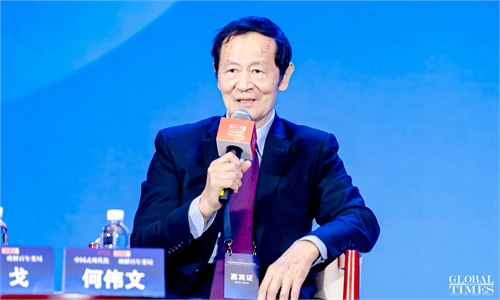
Illustration: Liu Xidan/GT
Reform and opening-up is an inescapable path for China. The establishment of the People's Republic of China on October 1, 1949, created the necessary social conditions for the country's modernization. This is not a recent issue, as the "Four Modernizations" were the first reforms officially launched by late Chinese leader Deng Xiaoping in 1978, focusing on agriculture, science and technology, industry, and national defense. In the current period of reform, the social productive forces are being liberated and developed, leading to significant advancements in national construction and providing a system that guarantees new vitality and material conditions for rapid development.The era of socialism with Chinese characteristics provides a more comprehensive institutional guarantee, a stronger material basis, and a more active spiritual force toward national modernization. The basic principles of socialism with Chinese characteristics are combined with the specific reality of China and its traditional culture. Driving modernization, the deepening of theoretical understanding, and the continuous strategic maturation and enrichment of practice have led to the development of a series of ideas, new insights and forward-looking conclusions, which enrich and develop theories of modernization. This new analysis of theories has played a significant role in promoting the country's historical achievements and changes over the years.
I have visited China multiple times and have witnessed firsthand the extensive and impressive changes in its economic, industrial, financial and social structures. These reforms have been crucial in compensating for the "two hundred years lost" that resulted in the backwardness faced by the founders of China after the liberation in 1949. This has led to the establishment of a parallel process between industrialization, information technology and computerization, urbanization, and agricultural modernization.
Contrary to what some propaganda may claim, there is no single model of modernization in the world, let alone one that can be imposed through force and violence, as is often the case. There is also no universal standard model that comes with an instruction manual. The analysis of China's reform and opening-up to the world is primarily a response to the challenges faced by a country with a massive population. It is based on a comprehensive synthesis of lessons learned from practical experiences and reformist and modernizing efforts in other countries, both positive and negative.
China's population of over 1.4 billion citizens will soon exceed the combined populations of existing developed countries. The difficulty and complexity of this situation are unprecedented, and the development path and promotion methods need to have their own unique characteristics. The success of China's development can be attributed to the reform and opening-up policies, which are a remarkable achievement in history. These reforms have been achieved through the collective efforts of the entire population, who have endured countless hardships. This is the right path toward achieving the great rejuvenation of the Chinese nation. Only by adhering to these principles can China continue to develop. Reform and opening-up are crucial tools for people to catch up with the rapidly changing times.
It is necessary to deepen the reforms and maintain an open economic system, establish a high-end market, improve the distribution system, and further stimulate the enthusiasm and creativity of all sectors of society. China should also promote high-profile opening-up to the rest of the world, enhance the bridging effect between domestic and international markets, create new advantages and opportunities in international competition, and provide strong momentum for the advancement and achievement of desired modernization goals. Currently, the world is undergoing major changes, unprecedented in a century, and the planet has entered a new period of turmoil and change. China's reform, development, and stability are facing profound contradictions. However, with confidence, China can overcome any kind of difficulty or challenge it encounters.
China's reform and opening-up also are of great significance to the world. Today, the most significant difference lies between the Chinese international perspective and the Western liberal perspective. Socialism itself encompasses ideological, historical and traditional integration content and is dedicated to the pursuit of cooperation and liberation for all peoples. China has consistently based its foreign policy on the five core principles of the Bandung Conference: mutual respect for sovereignty and territorial integrity; non-aggression; non-interference in internal affairs; equality and mutual benefit; peaceful coexistence.
China has always emphasized the importance of adhering to expanding reform and opening-up, and has continuously promoted the building of a community with a shared future for mankind. China's development cannot be separated from the world, and the world's prosperity also relies on China. It must be acknowledged that the liberal perspective may appear to pursue globalization, but in reality, it is driven by Western liberal-capitalist countries serving their own interests and multinational companies.
Currently, Western developed countries, influenced by the US, are emerging as an anti-globalization force as they realize that globalization increasingly deviates from their desires. In conclusion, countries around the world must first address issues of development and poverty, and reduce friction. Non-traditional global security issues such as food security, resource scarcity, population explosion, environmental pollution, prevention and control of infectious diseases, pandemics, and transnational crime can only be effectively addressed with the agreement and cooperation of all nations.
The author is an Italian expert on international affairs and Honorary Professor at Peking University. opinion@globaltimes.com.cn

